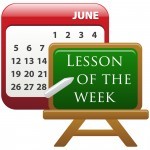Lesson of the Week: Scott Kremer- Posture Induced Hip Depth Issues Leading to Path Problems
By Wayne | Videos: Lesson of the Week

After watching Scott hit his first few shots, I knew that we could make some serious progress right away given that he was setting up well back into his heels. His shot pattern was a pull draw that turned into a major pull hook, and it was obvious that after setting up in his heels he was moving toward the ball immediately in the takeaway with his hands and arms as well as his hips. This is a common issue that gives the player a backswing that has a large progression from P1 to P3, an upright appearance at the top, and no room for the right arm to get in front of the body without pushing the hands well away from where they started at address. Once I got Scott to set up more out over the ball and concentrate on trying to deepen his right hip in the backswing, we could then talk about the feeling of the left arm staying more against the chest and the club approaching the ball from more behind him. We then added the idea of keeping the hips deep in the forward swing and aiming the lateral movement more to the left instead of straight out to the target, which reduced his lateral slide and gave him the feeling of sidearm throwing. The shorter swings we filmed at the end of the lesson with the help of the Spine Board looked particularly improved, and Scott left feeling like he was definitely on the right track.
Continue reading


